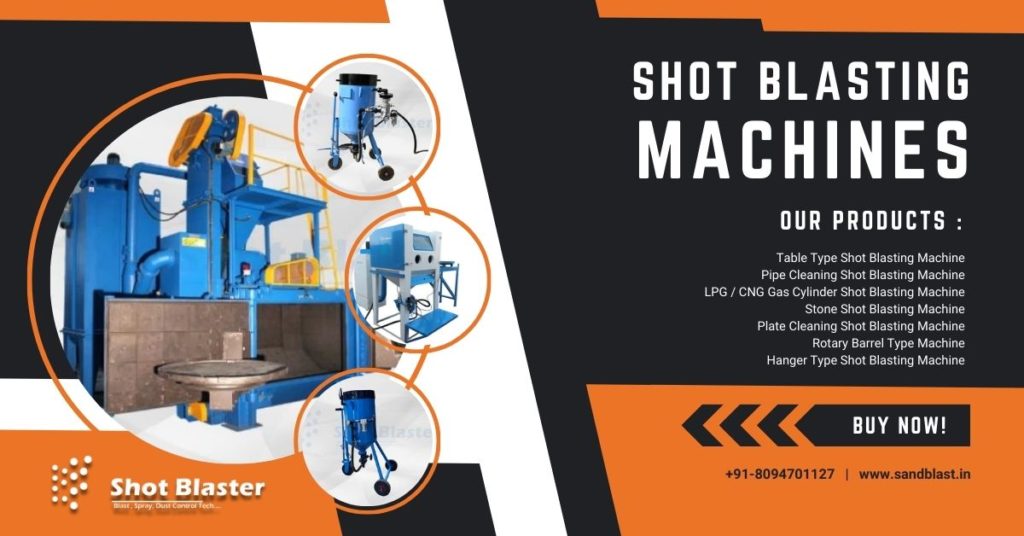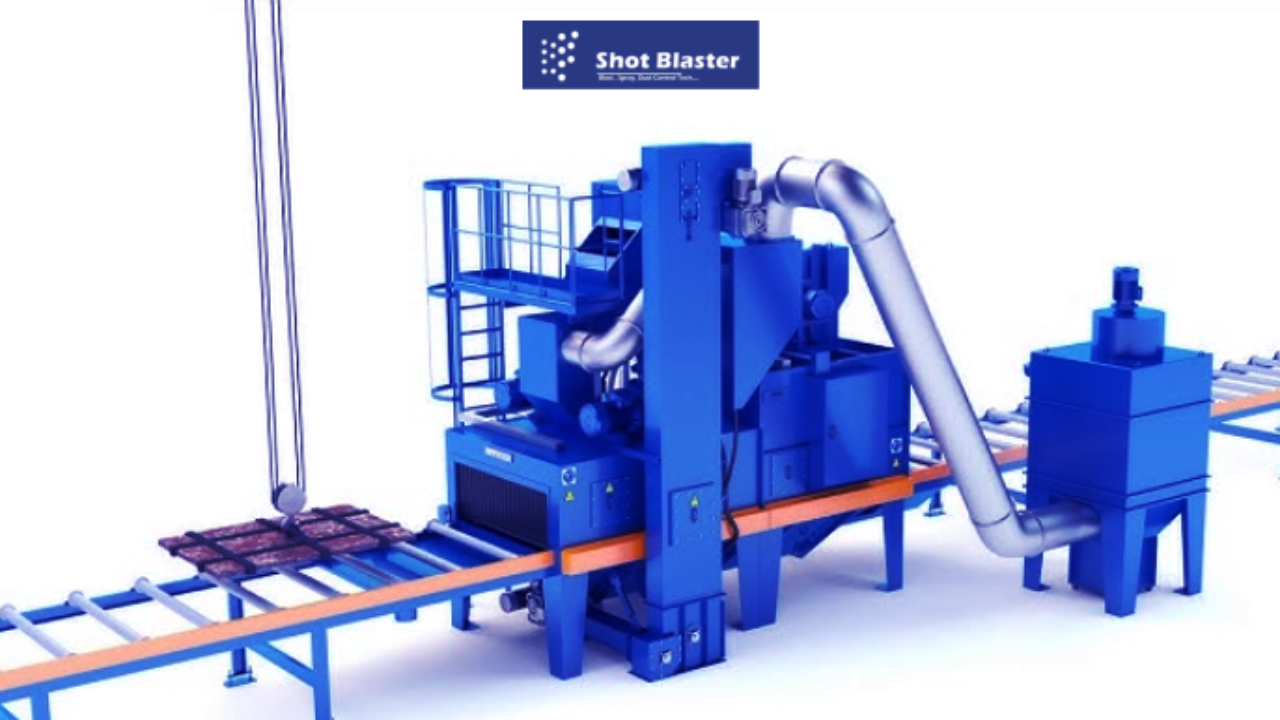Discover the key differences between sand blasting and shot blasting machines. Learn how each method works, their applications, and which one suits your needs in our comprehensive guide.

Introduction
When it comes to surface preparation, whether for cleaning, polishing, or enhancing a material’s texture, sand blasting and shot blasting are two common methods used across various industries. Both techniques might seem similar at first glance, but they have significant differences that affect their performance, efficiency, and application.
In this article, we’ll break down sand blasting vs. shot blasting machines, helping you understand which method is right for your project. If you’re wondering about the right machine for cleaning metal surfaces, removing paint, or preparing a surface for coating, this guide will shed light on the topic. So, let’s dive in!
What is Sand Blasting?
Sand blasting is one of the most well-known surface preparation techniques. It involves propelling abrasive particles—traditionally sand, though now often alternative abrasives—against a surface to clean or etch it. Sand blasting machine uses compressed air or a high-powered nozzle to direct a stream of abrasive material towards the surface being treated. This abrasive action effectively removes contaminants, rust, paint, or dirt.
How Does Sand Blasting Work?
Here’s a breakdown of the sand blasting process:
- Abrasive Material: Fine particles, typically sand (though other materials are often used), are loaded into the sand blasting machine.
- Air Pressure: A compressor forces air into the machine, propelling the abrasive material through a nozzle.
- Abrasive Action: As the abrasive material impacts the surface, it removes unwanted layers of coating or contaminants.
- Cleaning or Etching: The process may leave the surface either smoother or with a textured finish, depending on the application.
Common Applications of Sand Blasting
- Paint Removal: Used extensively in automotive, industrial, and construction industries to strip off old paint layers.
- Surface Preparation: Prepares surfaces for coating or adhesive bonding by creating a rough texture.
- Rust Removal: Helps in cleaning rust off metal surfaces, improving the durability of the metal underneath.
- Etching: Commonly used for creating decorative patterns on glass, stone, and other surfaces.
What is Shot Blasting?
Shot blasting, on the other hand, is a mechanical process that uses high-speed projectiles (shots) made of steel, aluminum, or other durable materials to clean or prepare surfaces. These shots are directed toward the surface, typically with the help of centrifugal force in a rotary drum or wheel.
How Does Shot Blasting Work?
Here’s an outline of how shot blasting operates:
- Projectiles: Shot blasting machines use steel balls, pins, or beads (called shot) as the abrasive material.
- Rotary Wheel or Drum: Unlike sand blasting, shot blasting uses a rotating wheel or drum to fling these projectiles at the surface.
- Impact and Cleaning: The high-speed projectiles impact the surface, removing contaminants and rust or leaving a textured finish.
- Recycling: The projectiles can be collected, cleaned, and reused multiple times.
Common Applications of Shot Blasting
- Cleaning Metal Surfaces: Shot blasting is widely used in industries that deal with heavy metal parts such as automotive, aerospace, and construction.
- Preparing for Coatings: Just like sand blasting, shot blasting helps prepare surfaces for coating, ensuring better adhesion of paint or other finishes.
- Surface Profiling: Shot blasting is often used to create a consistent, textured profile on metal surfaces, essential for processes like painting or coating.
- Rust and Paint Removal: Heavy-duty shot blasting machines are effective at removing thick layers of rust, corrosion, and old paint from industrial metal parts.
Take the next step – https://riyasingh258.blogaaja.fi/how-to-choose-the-right-shot-blasting-machine-for-your-needs/
Sand Blasting vs. Shot Blasting Machines: Key Differences Explained
Now that we understand what sand blasting and shot blasting are, let’s explore the differences between these two methods. While they may seem similar, their operational differences can significantly affect the result and efficiency of the process.
1. Abrasive Material Used
- Sand Blasting: Typically uses sand, but may also use other abrasive materials like glass beads, garnet, or aluminum oxide.
- Shot Blasting: Uses steel shot, stainless steel shot, or other hard metal pellets for more aggressive impact.
2. Method of Abrasive Application
- Sand Blasting: Air pressure is the key to blasting sand or other materials onto the surface.
- Shot Blasting: Shot blasting relies on centrifugal force generated by a rotating wheel or drum to throw projectiles at the surface.
3. Surface Finish
- Sand Blasting: Can create a smoother or slightly textured finish depending on the pressure and material used.
- Shot Blasting: Generally leaves a more textured, rough finish, perfect for creating profiles on surfaces for coatings.
4. Efficiency
- Sand Blasting: Sand blasting can be slower and less efficient for large-scale industrial applications due to the constant need to reload abrasives.
- Shot Blasting: Shot blasting machines are typically faster and more efficient for large-scale applications, as the abrasive material can be recycled and reused.
5. Application Type
- Sand Blasting: Ideal for delicate cleaning and etching of materials such as glass, stone, and small metal parts.
- Shot Blasting: Best suited for heavy-duty cleaning, rust removal, and surface preparation of large metal parts.
See how it works – https://riyasingh258.blogaaja.fi/a-complete-guide-to-understanding-shot-peening-machines/
Pros and Cons of Sand Blasting vs. Shot Blasting
Every method has its advantages and drawbacks depending on the nature of your project. Here’s a quick look:
Sand Blasting
Pros:
- Versatile: Can be used on a variety of materials including metals, glass, and stone.
- Precision: Good for fine detail work like etching or delicate cleaning.
- Readily Available: Sand blasting equipment is widely available and relatively easy to operate.
Cons:
- Dust Generation: Sand blasting produces a lot of dust, which can be hazardous without proper ventilation and safety measures.
- Less Efficient for Heavy-Duty Work: For large, industrial-scale jobs, sand blasting might be too slow or ineffective.
Shot Blasting
Pros:
- Speed and Efficiency: Perfect for large-scale industrial applications, saving time and effort.
- Recyclable Abrasive: The shot used in shot blasting can be recycled, making it more cost-effective.
- Heavy Duty: Ideal for cleaning and preparing metal parts with heavy coatings or rust.
Cons:
- Rougher Finish: The impact from shot blasting typically creates a rougher finish, which might not be desirable in some applications.
- Expensive Equipment: Shot blasting machines tend to be pricier, especially the larger, industrial models.
Take a deep dive – https://riyasingh258.blogaaja.fi/the-future-of-surface-finishing-with-airless-shot-blasting-solutions/
FAQs About Sand Blasting vs. Shot Blasting
1. Which method is better for cleaning metal surfaces?
If you’re dealing with heavy-duty metal cleaning, shot blasting is generally the better choice. It efficiently removes thick rust or paint and leaves a good profile for further coating.
2. Can sand blasting be used for delicate materials?
Yes, sand blasting can be more appropriate for delicate materials like glass or stone, especially if you need a fine or etched finish.
3. How often do I need to replace the abrasive material in shot blasting?
The great thing about shot blasting machine spare parts and accessories is that the abrasive material (the shot) can be recycled. You only need to replace it if the shot becomes too worn down or damaged.
4. Are sand blasting and shot blasting safe?
Both methods require safety precautions. Sand blasting can create harmful dust, so wearing protective gear such as respirators is necessary. Shot blasting generally involves less dust, but the projectiles can be dangerous, so protective equipment and shields are essential.
Conclusion
In the sand blasting vs. shot blasting machines: key differences explained debate, the right choice really boils down to your specific needs. Whether you’re looking for a fine finish on delicate surfaces or a fast and effective way to clean large industrial parts, both methods have their place in the world of surface preparation.
- Sand blasting is great for precision and versatility, especially when working with smaller or delicate surfaces.
- Shot blasting is the heavy-duty option for large-scale, industrial cleaning and surface preparation, offering speed, efficiency, and cost-effectiveness.
Choosing between the two depends largely on the nature of your work, the materials you’re working with, and the results you hope to achieve. Whatever your needs, both sand blasting and shot blasting are essential techniques in their own right, providing valuable solutions for surface preparation.



Leave a Reply